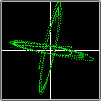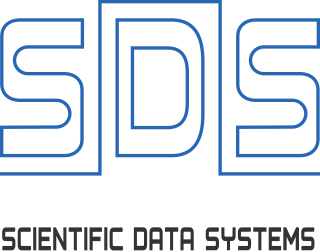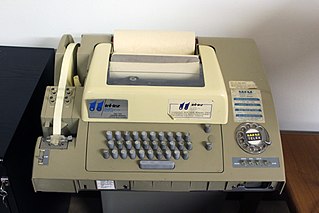Related Research Articles

In cryptography, the one-time pad (OTP) is an encryption technique that cannot be cracked, but requires the use of a single-use pre-shared key that is larger than or equal to the size of the message being sent. In this technique, a plaintext is paired with a random secret key. Then, each bit or character of the plaintext is encrypted by combining it with the corresponding bit or character from the pad using modular addition.

Radioteletype (RTTY) is a telecommunications system consisting originally of two or more electromechanical teleprinters in different locations connected by radio rather than a wired link. Radioteletype evolved from earlier landline teleprinter operations that began in the mid-1800s. The US Navy Department successfully tested printing telegraphy between an airplane and ground radio station in 1922. Later that year, the Radio Corporation of America successfully tested printing telegraphy via their Chatham, Massachusetts, radio station to the R.M.S. Majestic. Commercial RTTY systems were in active service between San Francisco and Honolulu as early as April 1932 and between San Francisco and New York City by 1934. The US military used radioteletype in the 1930s and expanded this usage during World War II. From the 1980s, teleprinters were replaced by personal computers (PCs) running software to emulate teleprinters.

A teleprinter is an electromechanical device that can be used to send and receive typed messages through various communications channels, in both point-to-point and point-to-multipoint configurations.

In the history of cryptography, Typex machines were British cipher machines used from 1937. It was an adaptation of the commercial German Enigma with a number of enhancements that greatly increased its security. The cipher machine was used until the mid-1950s when other more modern military encryption systems came into use.

In the history of cryptography, the ECM Mark II was a cipher machine used by the United States for message encryption from World War II until the 1950s. The machine was also known as the SIGABA or Converter M-134 by the Army, or CSP-888/889 by the Navy, and a modified Navy version was termed the CSP-2900.

The Lorenz SZ40, SZ42a and SZ42b were German rotor stream cipher machines used by the German Army during World War II. They were developed by C. Lorenz AG in Berlin. The model name SZ was derived from Schlüssel-Zusatz, meaning cipher attachment. The instruments implemented a Vernam stream cipher.
Gilbert Sandford Vernam was a Worcester Polytechnic Institute 1914 graduate and AT&T Bell Labs engineer who, in 1917, invented an additive polyalphabetic stream cipher and later co-invented an automated one-time pad cipher. Vernam proposed a teleprinter cipher in which a previously prepared key, kept on paper tape, is combined character by character with the plaintext message to produce the ciphertext. To decipher the ciphertext, the same key would be again combined character by character, producing the plaintext. Vernam later worked for the Postal Telegraph Company, and became an employee of Western Union when that company acquired Postal in 1943. His later work was largely with automatic switching systems for telegraph networks.
Telefunken was a German radio and television producer, founded in Berlin in 1903 as a joint venture between Siemens & Halske and the Allgemeine Elektrizitäts-Gesellschaft (AEG) . Prior to World War I the company set up the first world wide network of communications and was the first in the world to sell electronic televisions with cathode ray tubes, in Germany in 1934.

The TSEC/KW-26, code named ROMULUS, was an encryption system used by the U.S. Government and, later, by NATO countries. It was developed in the 1950s by the National Security Agency (NSA) to secure fixed teleprinter circuits that operated 24 hours a day. It used vacuum tubes and magnetic core logic, replacing older systems, like SIGABA and the British 5-UCO, that used rotors and electromechanical relays.

The KW-37, code named JASON, was an encryption system developed In the 1950s by the U.S. National Security Agency to protect fleet broadcasts of the U.S. Navy. Naval doctrine calls for warships at sea to maintain radio silence to the maximum extent possible to prevent ships from being located by potential adversaries using radio direction finding. To allow ships to receive messages and orders, the navy broadcast a continuous stream of information, originally in Morse code and later using radioteletype. Messages were included in this stream as needed and could be for individual ships, battle groups or the fleet as a whole. Each ship's radio room would monitor the broadcast and decode and forward those messages directed at her to the appropriate officer. The KW-37 was designed to automate this process. It consisted of two major components, the KWR-37 receive unit and the KWT-37 transmit unit. Each ship had a complement of KWR-37 receivers that decrypted the fleet broadcast and fed the output to teleprinter machines. KWT-37's were typically located at shore facilities, where high power transmitters were located.

The TSEC/KL-7, also known as Adonis was an off-line non-reciprocal rotor encryption machine. The KL-7 had rotors to encrypt the text, most of which moved in a complex pattern, controlled by notched rings. The non-moving rotor was fourth from the left of the stack. The KL-7 also encrypted the message indicator.
The National Security Agency took over responsibility for all U.S. Government encryption systems when it was formed in 1952. The technical details of most NSA-approved systems are still classified, but much more about its early systems have become known and its most modern systems share at least some features with commercial products.

Scientific Data Systems (SDS), was an American computer company founded in September 1961 by Max Palevsky, Arthur Rock and Robert Beck, veterans of Packard Bell Corporation and Bendix, along with eleven other computer scientists. SDS was the first to employ silicon transistors, and was an early adopter of integrated circuits in computer design. The company concentrated on larger scientific workload focused machines and sold many machines to NASA during the Space Race. Most machines were both fast and relatively low priced. The company was sold to Xerox in 1969, but dwindling sales due to the oil crisis of 1973–74 caused Xerox to close the division in 1975 at a loss of hundreds of millions of dollars. During the Xerox years the company was officially Xerox Data Systems (XDS), whose machines were the Xerox 500 series.
The DRTE Computer was a transistorized computer built at the Defence Research Telecommunications Establishment (DRTE), part of the Canadian Defence Research Board. It was one of the earlier fully transistorized machines, running in prototype form in 1957, and fully developed form in 1960. Although the performance was quite good, equal to that of contemporary machines like the PDP-1, no commercial vendors ever took up the design, and the only potential sale to the Canadian Navy's Pacific Naval Laboratories, fell through. The machine is currently part of the Canadian national science and technology collection housed at the Canada Science and Technology Museum.
Mercury was a British cipher machine used by the Air Ministry from 1950 until at least the early 1960s. Mercury was an online rotor machine descended from Typex, but modified to achieve a longer cycle length using a so-called double-drum basket system.

A fill device or key loader is a module used to load cryptographic keys into electronic encryption machines. Fill devices are usually hand held and electronic ones are battery operated.

Telex is a telecommunication service that provides text-based message exchange over the circuits of the public switched telephone network or by private lines. The technology operates on switched station-to-station basis with teleprinter devices at the receiving and sending locations. Telex was a major method of sending written messages electronically between businesses in the post–World War II period. Its usage went into decline as the fax machine grew in popularity in the 1980s.
NETRA is a software network developed by India's Centre for Artificial Intelligence and Robotics (CAIR), a Defence Research and Development Organisation (DRDO) laboratory, and is used by the Intelligence Bureau, India's domestic intelligence agency, and the Research and Analysis Wing (R&AW), the country's external intelligence agency to intercept and analyse internet traffic using pre-defined filters. The program was tested at smaller scales by various national security agencies, and is reported to be deployed nationwide as of 2022.
The Cipher Department of the High Command of the Wehrmacht was the Signal Intelligence Agency of the Supreme Command of the Armed Forces of the German Armed Forces before and during World War II. OKW/Chi, within the formal order of battle hierarchy OKW/WFsT/Ag WNV/Chi, dealt with the cryptanalysis and deciphering of enemy and neutral states' message traffic and security control of its own key processes and machinery, such as the rotor cipher ENIGMA machine. It was the successor to the former Chi bureau of the Reichswehr Ministry.

SIGTOT was a one-time tape machine for encrypting teleprinter communication that was used by the United States during World War II and after for the most sensitive message traffic. It was developed after security flaws were discovered in an earlier rotor machine for the same purpose, called SIGCUM. SIGTOT was designed by Leo Rosen and used the same Bell Telephone 132B2 mixer as SIGCUM. The British developed a similar machine called the 5-UCO. Later an improved mixer, the SSM-33, replaced the 131B2,
References
- 1 2 Ralph Erskine, "The 1944 Naval BRUSA Agreement and its Aftermath", Cryptologia 30(1), January 2006 pp14–15
- 1 2 3 Melville Klein, "Securing Record Communications: The TSEC/KW-26", 2003, NSA brochure, p. 4, (PDF)
- 1 2 "Awards to civilian personnel in respect of cypher machine development", 1955-1960, PRO AVIA 65/977